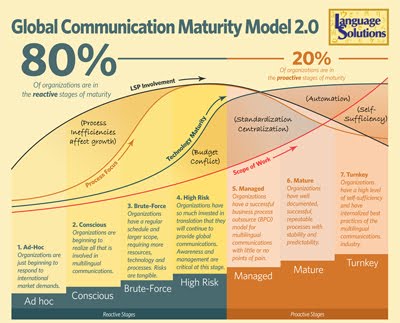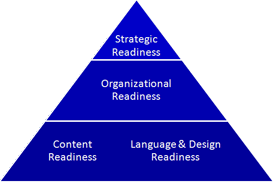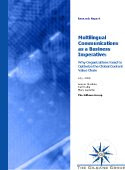The Translation Industry (aka Localization Industry) is one that has a relatively low barrier to entry. Anyone can enter this industry and set up shop as a translation company. These new companies may have little knowledge of process or technologies and they may help in reinforcing the buyer's perception that translation services are a commodity purchase. This low barrier to entry also indicates that the industry as a whole has no common platform of quality standards on which to operate.
In 2008, after working with a consultant and thinking of this idea of "buyer maturity", a team of us set out and tediously researched various maturity models and other standards such as the Capability Maturity Model, the People Capability Maturity Model (because it's not just the organization but the people within the organization), the Business Process Maturity Model, the ASTM Quality Standard on Translation, and the LISA Best Practices Guide.
We developed the Global Communication Maturity Model and then set out to identify a process management system for our industry with defined objectives, analysis, KPIs and measures, all set in a balanced scorecard framework. We are also heavily involved in Baldrige Performance Excellence and the balanced scorecard framework is second nature to us and seemed the right fit for this framework in order to provide our clients with a developed program to avoid the risks inherent in their own maturation.
At that time, unbeknown to us, Common Sense Advisory had offered a framework for buyers of translation services to consider in 2006, the Localization Maturity Model. Imagine our surprise when we came upon it about a year after we had been deep in our research. However, lately, it seems to have resurged in the news in our industry so with that, it is also a good time to highlight the research we have done and offer to not only buyers of translation services but also to LSPs out there who also work with this mindset and want to do more in the industry to move buyers through the model.
An interesting blog post by Jörgen Danielsen from 2006 shares some interesting insights in reaction to the emergence of the Localization Maturity Model (LMM) at that time and how it could help the industry to overcome the lack of quality standards. He argues that the progression on the buyer side as a factor of success might also assume that there is a certain level of maturity on the supplier side. He states further that the Localization Maturity Model could provide understanding between buyer and vendor in relation to the quality that is desired at different stages of maturation.
Bert Esselink also wrote in reaction to the LMM that "buyers of localization should really look at their procurement model and make informed decisions at different stages of maturation."
That was back in 2006 and progress, as well as news on buyer maturation, has been very slow. Our industry has mostly been preoccupied with technology disruptors like Machine Translation and crowd sourcing as a common threat to, and subsequently defined as a differentiating opportunity, in our industry.
Most likely, the biggest reason for lack of progress is that there are plenty of buyers out there who still do not know what to ask for when it comes to buying translation services. We've written earlier in blog posts since 2008 on buyer maturation and have offered tools, analysis, perspectives and case studies with: Understand What You Buy, Too much focus on lagging measures, Global Readiness Audit and our personal favorite, Bring on the pain! When Translation matters....it's too late!
Esselink hinted at this lack of progress in his blog in 2006. "If there is no common understanding of what the cost drivers are of translation services, how can we ever expect buyers to compare apples to apples?" Some companies, however, do move beyond the price per word models and are getting a better understanding of cost factors. However, we have learned that even the most detailed client RFPs lack realistic expectations. Somewhere in the learning process, the client has misunderstood the important cost, quality and turnaround factors and how to evaluate these in relationship to each other.
The nice thing about RFPs is that you usually get to see questions from other LSPs as well. A recent RFP with a big Fortune 500 company revealed that our competing LSPs simply had no insightful questions to ask. While there were technical questions about payment terms and others about some erroneous omissions in the RFP regarding word count and various assumptions, we could honestly say that we were the only LSP to ask demanding questions about their level of understanding of the "cost, quality and turnaround" expectations. We attributed more than 50% of all questions came directly from us. Perhaps our industry is tired of explaining the value of what we do. We're talking....is anyone out there listening?
In Danielsen's blog, Jorgen argues that the success of localization and optimization of translation processes is not only a factor of the Localization Maturity of a buyer, but also the Localization Maturity of the vendor (the LSP). So buyers....start asking this question to LSPs - "Where are you on the Maturation Model?"
We are really excited to see that now, in 2013, others in our industry are starting to talk more about this. Is this enough? What can we do collectively?
Consider that the top 10 Google search results for "Localization Maturity" include the two blogs from 2006 that we mentioned earlier. Their insightful questions still stand as something to be determined in our industry:
1. Can we as an industry help buyers to become more sophisticated in their procurement of localization? (Tweet this!) and
2. Can Localization Maturity be the answer to realistically define quality in our industry to our clients?
Common Sense Advisory is currently offering training to LSPs to teach them to approach buyers of translation services with this maturity model. At this time, it appears that it is being adopted by LSPs who are willing to pay the membership fees to attend their training or a conference, but this may certainly be cost prohibitive to many small to medium sized LSPs (the bulk of the industry) who are still influencing buyer perceptions.
While many LSPs may walk away with the entrée to offer to their prospects (the maturity model which is the framework for clients to assess their current maturity), there are no 'side dishes' being offered to the LSPs to give companies the tools to do assessment, a framework of objectives, a road map of key process areas to focus on, etc. There is definitely thought leadership in this area from LSPs, but it takes time to develop and document these things when you are not paid to develop them unless hired as a consultant by the organization that is in a pain point on the maturation model.
What can we do collectively? There are other process minded LSPs that are out there that may have developed programs and tools that they offer their clients. Why can't we come together and form a new niche in the industry? What can we do to change the status quo and not only move organizations through maturation with less risk and change their perceptions that come along with that but also set out and proclaim our status as Mature Suppliers.
We're willing to share what we have developed......who is with us on this? We are seeking those LSPs that have a customer first culture, those that have agility and those who want to help organizations succeed with the knowledge we have developed.\
Read our follow up post on LSP Maturity here:
http://www.langsolinc.com/lsp-maturity-ideal-customer-profile/











3 comments:
thanks for sharing, your article is very helpful and useful and i love reading it..
Thank you both for your comments. We're glad it is appreciated.
Post a Comment